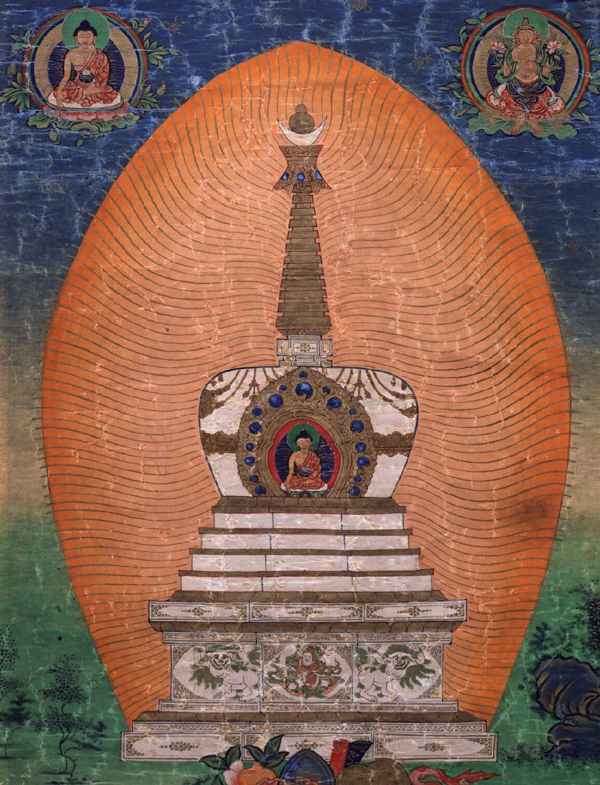The Second Shechen Rabjam
The Second Shechen Rabjam, Gyurme Kunzang Namgyel (zhe chen rab ‘byams 02 ‘gyur med kun bzang rnam rgyal), was born in Rudam Yangkhyil (ru dam g.yang ‘khyil) in 1713, the water-snake year of the twelfth sexagenary cycle.  He was the younger brother of the Second Dzogchen Drubwang, Gyurme Tekchok Tendzin (rdzogs chen 02 ‘gyur med theg mchog bstan ‘dzin, 1699-1758). It is said he proclaimed himself to be the reincarnation of Tenpai Gyeltsen (bstan pa’i rgyal mtshan, 1650-1704) soon after he started speaking. Disciples of the First Rabjam subsequently identified the child as the Second Rabjam. In 1717, at the age of five the boy was escorted to the monastery his previous incarnation had founded, Shechen Orgyen Chodzong Drubde (zhe chen o rgyan chos rdzong sgrub sde) in Derge, Kham.
He was the younger brother of the Second Dzogchen Drubwang, Gyurme Tekchok Tendzin (rdzogs chen 02 ‘gyur med theg mchog bstan ‘dzin, 1699-1758). It is said he proclaimed himself to be the reincarnation of Tenpai Gyeltsen (bstan pa’i rgyal mtshan, 1650-1704) soon after he started speaking. Disciples of the First Rabjam subsequently identified the child as the Second Rabjam. In 1717, at the age of five the boy was escorted to the monastery his previous incarnation had founded, Shechen Orgyen Chodzong Drubde (zhe chen o rgyan chos rdzong sgrub sde) in Derge, Kham.
The Third Minling Trichen, Rinchen Namgyel (smin gling khri chen 03 rin chen rnam rgyal, 1694-1758), gave him teachings and empowerments on various treasures, mainly from the New Treasure Teachings of the Minling tradition (smin gling gter gsar). He later studied a great variety of topics, both basic and advanced, under a number of outstanding teachers. His main teachers are classified as “The Five Unequalled Lords of the Family” (rigs bdag mtshungs med lnga): his brother, Dzogchen Gyurme Tekchok Tendzin; the Fifth Dorje Drak Rigdzin, Kelzang Pema Wangchuk (rdo rje brag rig ‘dzin 05 bskal bzang pad+ma dbang phyug, 1719/20-c.1770); Gyurme Kelzang Pelgye (‘gyur med skal bzang ‘phel rgyas, d.u.); andGyurme Kelzang Tenpel (‘gyur med skal bzang bstan ‘phel, d.u.). Additionally, he studied with the Thirty-fourth Ngor Khenchen, Pelden Chokyong (ngor mkhan chen 34 dpal ldan chos skyong, 1702-1760); the Third Khamtrul, Kunga Tendzin(khams sprul 03 kun dga’ bstan ‘dzin, 1680-1728); and Drime Zhingkyong Gonpo(dri med zhing skyong mgon po, b.1724) of Katok Monastery (kaH thog dgon).
Although there is some confusion surrounding the details of the founding of Shechen Monastery, it is most likely that in 1734 or 1735, in the Derge district of Kham, Gyurme Kunzang Namgyel founded a second branch of Orgyen Chodzong Drubde, which his predecessor had founded in 1690 or 1695, on the far side of the valley from the earlier institution. It was this establishment, known as Shechen Monastery (zhe chen dgon pa), that flourished, growing into one of the six major centers of Nyingma learning in Tibet.
He is known for giving annual teachings on the Dzogchen Khandro Nyingtik(mkha’ ‘gro snying thig) in the tradition of the Dzogchen Drubwang lineage, for which a large number of devotees would gather from near and far. He taught on many other topics and also was known to have given oral-transmissions of the entire Kangyur (bka’ ‘gyur) or translated words of the Buddha.
The disciples of the Second Rabjam included Kunzang Nyendrak Gyatso (kun bzang snyan grags rgya mtsho, d.u.) the Sib Tulku, Kunzang Pema Wangyel (sib sprul sku kun bzang pad+ma dbang rgyal, d.u.); Sanggye Rabten (sangs rgyas rab brtan, d.u.); the First Pukhang, Pema Rinchen (phug khang 01 pad+ma rin chen, b.1723); Zhedrung Pema Namdak (zhe drung pad+ma rnam dag, d.u.); Tromza Ngawang Pema (khrom bza’ ngag dbang pad+ma, d.u.); and the sixth abbot of Dzogchen, Namkha Tsewang Chokdrub (rdzogs chen gdan rabs 06 nam mkha’ tshe dbang mchog grub, b.1744).
The Second Rabjam’s collected works are said to have comprised of nine volumes but they are not extant at this time.
He passed away at the age of fifty-seven in 1769, the earth-ox year of the thirteenth sexagenary cycle, after appointing Shechen Pema Sangngak Tendzin (zhe chen pad+ma gsang sngags bstan ‘dzin, d.u.) as his successor.
In 1771, Rigdzin Peljor Gyatso (rig ‘dzin dpal ‘byor rgya mtsho), born in Yilhung, Kham (mdo khams yid lhung), was identified as the Third Shechen Rabjam.
Source; The Treasury of lives
Leave a Reply